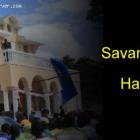ADVERTISEMENT
Nippes Department - Haiti Observer Blog
Nippes Department, Haiti Observer Blog. Read the following articles about Nippes Department
The Open-Hearted People of L'Asile
L'Asile, a small village with a population of 32,000, is a cityship within the Ainse-a-Veau Arrondissement, part of Nippes Department.
The residents of L'Asile experience back-breaking poverty, earning only $300 USD each year. They derive their income from farming produce on small tracts of land. Bringing their crops to market provides them with enough money to keep them from starvation.
L'Asile is surrounded by hills, subject to grinding poverty, and many families make do with thatched-roof dwellings. For those who are able to afford the material, they build tin-roofed abodes. But whatever kind of housing they reside in, the population does not have either running water, or a dependable source of electricity.
Miragoane a Proud Community
Miragoane rests on the northern coast of the western peninsula of Haiti. As part of the Nippes Department and its capital, it is a main port of second-hand imports from Miami. At the port, merchants purchase imports and vend them at Miragoâne street stalls.
The history of Miragoane port, among the largest natural ports of the globe, was as a gathering place for the Spanish when the island was called Hispaniola. Eventually the French chased them out.
Miragoâne, ringed by mountains, is protected by Ile Gonave, which lies above it on an inlet of the Caribbean Sea. During its early history, gold was discovered and mined there.
Fonds-des-Negres and its Infrastructure
In the southern section of Haiti lies the cityship of Fonds-des-Nègres, which straddles both Miragoâne and Nippe Departments. The city, founded in 2003, was born of the capital city of Miragoâne. Three other communes make up Miragoâne: Bouzi, Pemerle, and Cocoyers-Duchene.
Roads in Fonds-des-Nègres are in very bad shape, many of them dirt roads. At this time, however, road-work projects are proceeding, the roads now being built and repaired to bring them up-to-date with current safety codes. In areas where heavy rains block passage of traffic because of spontaneous lakes created by the deluges, bridges are going up as well.
Anse-a-Veau in Nippes Department
Within the Department of Nippes, sits the Anse-à-Veau Arrondissement. Five hamlet-like villages comprise Anse-à-Veau: Arnaud, L'Asile, Petit-Trou-des-Nippes, and Plaisance-du-Sud.
Anse-à-Veau has a population estimated to be between 31,000-55,000. Founded in 1721 as a cityship, it lies below left of Ile Gonave and an inlet of the Caribbean Sea. Three sub-divisions make up Anse-à-Veau: Grande-Rivière-Joly, Sault-des-Baril-Moinsard, and Baconnois-Grand-Fond.
Following Haiti's magnitude 7.0 2010 earthquake, which reduced most of Haiti to rubble, thousands upon thousands of Port-au-Prince survivors overflowed Anse-à-Veau, severely straining its people and services.
Anse-à-Veau's main income-producing activities are agriculture and fishing. Farmlands produce coffee, sugarcane, lemons, and oranges, and use sustainability practices. Cotton-growing also takes place. The small-craft fishing industry plies its trade along Anse-à-Veau's coastline.
The Town of Arnaud, a Flood Survivor in Haiti
Arnaud, one of the smallest villages in Haiti, is part of the Anse a Veau Arrondissement in the Nippes Department. Its population numbers under 19,000 inhabitants. The village's smallness contributes to over-crowding, which makes living conditions more difficult. Arnaud is sub-divided into three communes: Baconnois-Barreau, Baquet, and Arnaud City Center. Arnaud has only recently been incorporated as a separate municipality, having been created from the town of Anse-a-Veau.
The main form of economic activity is farming. Farmers grow crops of coffee, rice, banana, lime, sugar cane, and cotton, which afford them a modest standard of living according to Haitian standards.
Town of Baraderes, rich in Coffee Production
Baradères, capital of the Baradères Arrondissement, formed in 2003 as part of Nippes Department. A commune with a population of 30,000, situated on the northwest peninsula of Haiti, it is well known for its agricultural output. Local farming, an economic force in the village, yields enough crops, to maintain a subsistence standard of living.
Baradères one export is coffee, beginning its exportation in 2006. The roasting technique creates an intensely-flavored and sweet French Roast. The fair-trade coffee produces enough profits to erect schools and medical facilities in Nippes Department.
Baradères terrain contains mountain ranges and vales, extending 60-plus miles away from the center. Homesteading occurs mostly in the vales, more hospitable for farming. Baradères River streams through the vales, pouring into the Gulf de la Gonave about a mile out of the village.
Town of Grand-Boucan in Haiti
Grand-Boucan is a cityship within the Baradères Arrondissement, part of Nippes Department. A coastal town, located on the northwestern part of Haiti's peninsula, it gazes out at the jewel-toned Caribbean Sea. The nearest large cities are Les Cayes and Port-au-Prince. Grand-Boucan, a town based on tradition, contains a largely Catholic community. Other practicing faiths are Protestant and Voodoo.
The sparkling Caribbean Sea can be seen from the center of town, and the sight of fishermen carrying their nets to the beaches lets tourists know this agricultural activity puts food on the table for many poor Haitian families living there. The sight of the city from a sea vessel, bobbing off the coast, inspires awe with its breath-taking mountain peaks set against a Caribbean blue sky, unlike no other in the world.
Michel Martelly and Bishop Pierre-Andre Dumas in Anse-a-Veau
In July, Haitian President Martelly, along with Bishop Pierre-Andre Dumas and Food for the Poor Representative Daniel Rouzier, visited a village located in Nippes Department's Anse-à-Veau that was built for the displaced victims of the 2010 earthquake and the various floods in the department. It was a project done by the NGO Food for the Poor where about sixty homes were built. The trio also launched the town's new Sainte Anne Polytechnic School during their visit.
The Martelly administration has been launching several projects for the development of Haiti's economy and for the welfare of all Haitians, especially the victims of the devastating 2010 earthquake. It has also urged for the decentralization of the government's power and resources to local governments and smaller public sectors in order to extend its public service to the smallest of communes and villages.
The Town of Paillant, Haiti
In the southern part of Haiti sits Paillant (known as Payan in Créole), a tiny village with an estimated population of 16,000 inhabitants. Part of the Miragoâne Arrondissement, which is part of Nippes Department, the metropolitan heart of the village lies hidden behind mountain ranges on the Tiburon peninsula. Like Miragoâne, it lies below Ile Gonave and an inlet of the Caribbean Sea. Paillant was carved out of the southwestern area of Miragoâne City. Two communes comprise Paillant: Bezin and Salagnac.
As in other parts of the Miragoâne Arrondissement, specifically Fonds-des-Nègres, roads are nearly impossible to travel on. Few paved roads exist, the majority of them dirt and rock-embedded conduits of vehicular traffic. Travelers complain constantly of tires wearing out quickly.
Petit-Trou-de-Nippes Natural Beauty a Drawing Card for Tourists
A slice of paradise inhabits the northwestern section of Haiti's peninsula, the town of Petit-Trou-de-Nippes. Situated within the Anse-à-Veau Arrondissement, it is a commune of the Nippes Department. The other communes are Arnaud, Plaisance-du-Sud, Anse-à-Veau, and L'Asile.
Resting on the coast of the azure Caribbean Sea, its waters are home to frolicking dolphins, a pleasing and thrilling sight to visiting tourists, as well as stunning sunrises and sunsets. The town of
Petit-Trou-de-Nippes is a perfect vacation spot for those who like walking in natural environments, enjoying quietude and serenity.
But to arrive at the magnificent splendor of Petit-Trou-de-Nippes from Port-au-Prince, a journey of up to five hours is necessary. Dirt roads--the bane of many small towns in Haiti--plus bodies of water are strewn along the way, challenging travelers. Yet the indescribable beauty that awaits at the end compensates. Sand as white and fine as sugar, and crystalline waters refresh one's senses.
Our objective is to share with you news and information about Haiti and the people of Haiti. Traditions, habits and the way we were or grew are alive in this site. We highly recommend that you Subscribe to our Newsletter and also share with us some of the things that are memorable and made us unique people.

 Haitian Thanksgiving
Haitian Thanksgiving  Saint Marc, Haiti
Saint Marc, Haiti  The Town of Savanette, Haiti
The Town of Savanette, Haiti  Informative Marketing and Advertising in the Haitian Community
Informative Marketing and Advertising in the Haitian Community  Battle of Vertieres
Battle of Vertieres